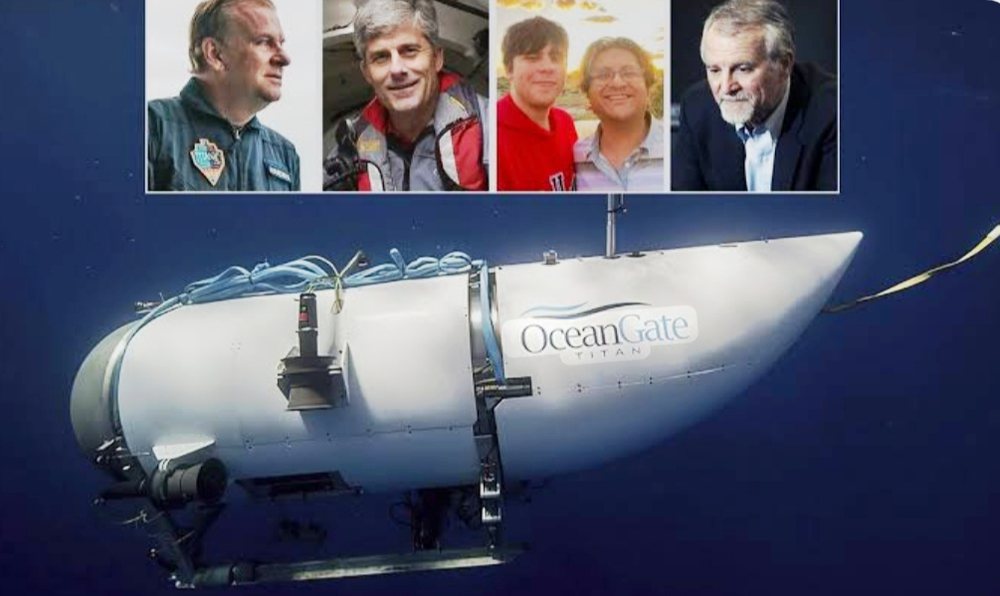
The 335-page report published on August 5th shows that the Titan, a 22-meter-long submarine, exploded on June 18, 2023, due to factors that were largely within the control of the company that operated it.
By Jeanine Santucci
USA TODAY
A newly released Coast Guard report has found that the explosion of the Titanic-bound submarine in June 2023, a world-record tragedy in which five people were killed, was "preventable" but was fueled by its inadequate construction and toxic workplace culture.
The 335-page report published on August 5th shows that the Titan, a 22-meter-long submarine made of carbon fiber, exploded on June 18, 2023, for reasons that were largely within the control of the company that operated it, OceanGate.
These causes include an "inadequate process followed by OceanGate regarding the design, certification, maintenance and inspection of the Titan," the report said.
All five people on board died in the explosion: OceanGate founder and CEO Stockton Rush, British billionaire Hamish Harding, French maritime expert Paul-Henri Nargeolet, Pakistani businessman Shahzada Dawood and his 19-year-old son, Suleman Dawood.
“This marine accident and the loss of five lives was preventable,” said Jason Neubauer, chairman of the U.S. Coast Guard’s Board of Marine Investigation for the Titanic. “The two-year investigation has identified a number of factors that led to this tragedy, and has drawn valuable lessons to prevent future events.”
Report Issues Harsh Criticism of OceanGate and Its CEO
According to the Coast Guard Report, OceanGate’s failure to follow safety, testing, and maintenance protocols is directly to blame for the catastrophic explosion. The report states that for years before the explosion, OceanGate “used scare tactics, scientific operations permits, and the company’s favorable reputation to avoid regulatory scrutiny.”
The Titan was not registered, certified or inspected by any recognized organization, the report said.
According to the Report, if Rush, the CEO, had survived, he could have faced criminal charges. Investigators concluded that he "engaged in negligence that led to the deaths of four individuals."
"It is important to note that the determination of whether or not a crime was committed would have to be reached by the Department of Justice's analysis and investigation, but that in this case it will not be conducted because Mr. Rush is deceased," the report states.
Chronology of Titan's final moments
The report documents the exact time when
Titan lost communication with Polar Prince,
the support ship where the rest of the expedition crew was located, and that in
The expedition began on June 16, when the Polar Prince set sail from Newfoundland and Labrador,
in Canada. Two days later, Polar Prince
arrived near the wreck of the Titanic in the North Atlantic and the submarine was launched into the sea.
8:30 a.m.: The five crew members board and lock themselves in the submarine.
9:14 a.m.: Titan begins its free fall toward Titanic. Usually, during
During the dives, the Titan maneuvered near the ocean surface to perform a "communication check," but was reportedly unable to do so on its final descent.
9:28 a.m.: The Titan crew, communicating via abbreviated text messages, confirms that the ship is descending at a rate of 33 meters (more than 100 feet) per minute.
9:53 a.m.: Communication between Titan and Polar Prince is lost for about 15 minutes, so the search ship repeatedly sends this message: "Do you see Polar Prince on your screen?"
10:08 AM: Titan sends message "k" to Polar Prince, restoring communication. The ship continues to send messages regarding its position.
10:47:02 AM: Titan sends a message that it has "dropped two weights," indicating that it has dropped ballast weights to slow its descent.
10:47:08 a.m.: Titan sends an automatic transmission recording its final location at a depth of 3,346.28 meters (just under 11,000 feet).
10:47:09 a.m.: The Titan explodes, killing everyone on board instantly. "Two seconds later, the TITAN Communications and Tracking Team on the POLAR PRINCE heard an 'explosion' coming from the ocean surface, which the investigation later linked to the TITAN explosion," the report says. "After this, all communications and tracking of the TITAN were lost."
7:10 p.m.: After unsuccessfully following mission protocols to reestablish communication with the Titan, the Polar Prince alerts the Canadian Coast Guard that the Titan is in distress. The Canadian Coast Guard instructs the crew to notify the U.S. Coast Guard, initiating a multinational search operation that lasted until a debris field was found on June 22.
What factors led to the Titan explosion? Poor construction, toxic workplace
The report identified eight main factors and several factors that led to the disaster:
• OceanGate's design and testing procedures were inadequate to ensure the engineering precision needed for a ship like the Titan, which itself had to navigate in hazardous conditions.
• OceanGate did not conduct analyses to determine the expected lifespan of Titan's body.
• OceanGate relied heavily on the real-time monitoring system for the carbon fiber hull, but did not perform a "full analysis" based on the data provided by the system.
• Kompania vazhdoi të përdorte Titanin edhe pas një serie incidentesh që "kompromentuan integritetin e trupit të saj" dhe përbërësve të tjerë të nëndetëses, pa e vlerësuar ose inspektuar atë.
• Projektimi dhe ndërtimi i vetë trupit të Titanit "tregoi të meta që dobësuan integritetin e përgjithshëm strukturor".
• OceanGate nuk i hetoi siç duhet aksidentet e mëparshme.
• Kompania e kishte një "mjedis toksik pune" që shfaqej në shkarkimin e punonjësve ose kërcënime për shkarkime nga puna për të shkurajuar punonjësit dhe kontraktorët që të flisnin hapur për shqetësimet që kishin në lidhje me sigurinë.
• OceanGate nuk e ruajti ose mirëmbjti siç duhet Titanin gjatë periudhës së pushimit.
Faktorë të tjerë që u përcaktuan në raport si kontribues të katastrofës përfshijnë mosndjekjen e protokolleve të shkruara të vet kompanisë për sigurinë; mburrjen e Rush se trupi i Titanit ishte "i pathyeshëm", duke krijuar një ndjesi të rreme sigurie për pasagjerët dhe rregullatorët; dhe dhënien përparësi të çështjeve financiare në raport me sigurinë. Gjithashtu, pjesërisht faji bie edhe mbi mungesën e rregullave për nëndetëset në ujërat e SHBA-së dhe mosshfrytëzimi i një mundësie për të ndërhyrë pasi Administrata e Sigurisë dhe Shëndetit në Punë e SHBA-së deshi shumë kohë për të hetuar një ankesë të vitit 2018 të një sinjalizuesi, thuhet në raport.
Anija e kërkimit dëgjoi një “bum” kur shpërtheu Titani
Anëtarët e ekuipazhit në bordin e Polar Prince u thanë hetuesve se dëgjuan një "bum" në momentin kur humbën komunikimet me Titanin, por nuk i dhanë shumë rëndësi në fillim.
Sipas raportit, zhurma u dëgjua rreth orës 10:47:11 të paradites, dy sekonda pas shpërthimit. Në atë çast, drejtuesi i komunikimeve dhe ndjekjes i OceanGate që ishte në dhomën e hartave, iu drejtua një punonjësi tjetër të OceanGate duke i thënë tha: "Çfarë ishte ajo bum?".
Më vonë, kapiteni i Polar Prince u tha hetuesve përmes një deklaratë me shkrim: “Tani që di diçka më shumë, mendoj se rreth çastit kur thuhet se humbën komunikimet e ndjeva POLAR PRINCE të dridhej, por në atë kohë nuk e menduam fare këtë gjë… ishte e parëndësishme.”
Pamjet e atij çasti në Polar Prince të publikuara më herët këtë vit, me Wendy Rush, bashkëshortja e Drejtorit Ekzekutiv të OceanGate, dhe Gary Foss, pjesë e ekipit të gjurmimit dhe komunikimit me nëndetësen, të cilët dihet se ishin në dhomë. Në pamjet filmike, tingulli ngjan si një goditje “bum” e mbytur, dhe as Rush, as Foss, nuk dukeshin të alarmuar ndërsa punonin për të mbajtur komunikimin me Titanin.
Roja Bregdetare ka thënë se goditja e mbytur besohet të jetë tingulli i shpvrthimit, që arriti sipërfaqen e oqeanit pak çaste më vonë.
Cila ishte pika e fundit që i dha fund Titanit?
The report states that investigators were unable to definitively determine the exact cause of Titan's hull failure, but pointed to the loss of structural integrity of either the carbon fibers that made up the hull or the adhesive joint within the ship's cylindrical pressure hull.
A 2013 Boeing feasibility study found that the performance of the adhesive joints was uncertain and recommended further research into how the intense pressure at the ocean depths would affect them, which OceanGate did not do, the report said. The study also noted that carbon fiber had not been proven for submarines at such depths.
Investigators examining the body debris saw that the adhesive used to bond the carbon fiber body to the titanium elements had "disconnected from the entire front segment."
"Any crack or break in one of the adhesive joints would have led to the explosion of TITAN due to the extreme pressures occurring at its maximum depth," the report said.
When the submarine exploded, investigators believe its viewing port, or window, was blown out; it was never found in the debris area, but its retaining ring was found bent outward with its 16 bolts severed, the report said.
Titan passengers died immediately after the explosion
The Titan's hull explosion exposed its passengers to water pressure of 4,930 pounds per square inch, causing their instant death, the report reveals.
When authorities were first told that the Titanic was in danger, a multinational search expedition was launched to find signs that the submarine might have surfaced with the passengers still alive, but perhaps running out of oxygen. It was only after the discovery of the debris field on the ocean floor on June 22 that investigators definitively determined that the ship had exploded, killing everyone on board.
https://www.usatoday.com/story/news/nation/2025/08/05/titan-submersible-implosion-coast-guard-report/85522207007/?utm_campaign=channel&fbclid=IwQ0xDSwL-9ztleHRuA2FlbQIxMAABHqMRNhaG8BKUEFj9cpvBKMTz5HKWQfmNjVMaOxyWIBNVsnyT2yhZm1e9AauC_aem_GK7VrT_EVSyUpch9Iaq5XQ&sfnsn=mo






















